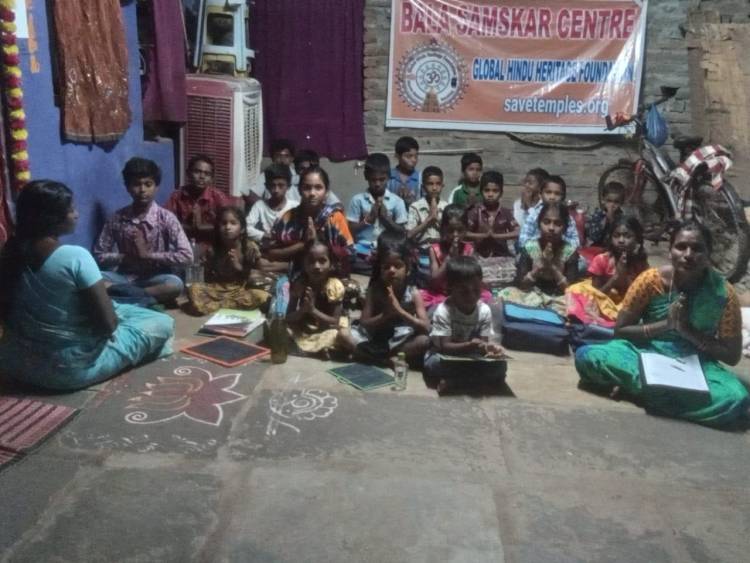[GHHF] Bala Samskar Kendras – Students were inspired by listening to life, patriotism and sacrifice of Chandrasekhar Azad who fought for the liberation of Bharat from British.
 Global Hindu Heritage Foundation is committed to transmit the richness of Sanatana dharma to the youngsters in terms of the depth and width of knowledge, the sacrifices of national heroes, miracles of Maha Rishis, science and mathematics, and the importance of maintaining the traditions and customs. So many young people worked for the liberation of Bharat from the British rule. One such patriot is “Azad.”
Global Hindu Heritage Foundation is committed to transmit the richness of Sanatana dharma to the youngsters in terms of the depth and width of knowledge, the sacrifices of national heroes, miracles of Maha Rishis, science and mathematics, and the importance of maintaining the traditions and customs. So many young people worked for the liberation of Bharat from the British rule. One such patriot is “Azad.”
Chandrasekhar Azad, the immortal hero who fought armed struggle for the liberation of the motherland in the freedom movement of India. He is a unique hero who made our nation proud who created tremors in the hearts of the British along with Bhagat Singh, Rajaguru, Sukhdev, Pandit Ram Prasad Bismil, Thakur Roshan Singh, Prem Kishan Khanna and Ashfaqullah Khan. Azad's full name is Chandrasekhara Sitaram Tiwari, who is known as the guide of Bhagat Singh. He is also known as Panditji. After 1857 he was the first of the heroes who fought armed struggle. Azad was a firm believer that righteous war was right for the protection of the country's people.
Chandrasekhar Azad was born on 23rd July 1906 to Pandit Sitaram Tiwari and Zagarani Devi in Bawra village, Jhabua district, Madhya Pradesh state. He completed his primary education in his own village and pursued his higher secondary education in a Sanskrit school in Varanasi. He was a devotee of Hanuman since childhood.
Azad was deeply disturbed by the Jallianwala Bagh incident in Amritsar in 1919. After that, he actively participated in the non-cooperation movement led by Mahatma Gandhi in 1921. He was arrested at the age of fifteen for the crime of participating in this movement. "What's your name?" court asked him during the trial. Asked by the magistrate, he shouted "Azad" in a loud voice. The magistrate sentenced him to 15 lashes. But every time he was whipped, he shouted Bharat Mataki Jai. Since then, his name has been fixed as Chandrasekhar Azad. The non-cooperation movement awakened the latent revolutionary zeal in Azad. At any rate, he was determined to free India from the hands of the British. As expected, he founded the Hindustan Socialist Republican Association. He became a mentor to Bhagat Singh, Sukhadev, etc.
Azad fired at J.P. Sanders in Lahore in 1928 to take revenge on the British for the Kakori train robbery in 1926, Viceroy train burning in the same year, Lala Lajpati Rai's death. Involved in revolutionary activities like shooting Saunders. At one stage, Azad was a nightmare for the British police. He made a police hitlist and did not let go until he was killed. After being arrested at the age of fifteen, Azad, who came out and took part in the struggle, was never caught by the police until his death.
But on February 27, 1931, when he reached Alfred Park in Allahabad to meet his two companions, he was surrounded by British police on the tip of informers. Azad was warned to surrender. However, with his iron will he did not surrender to the police and fought alone and killed three policemen. After fighting till exhaustion, he shot himself at the last moment with the only remaining bullet he had.
The British police, who wanted to catch Azad alive till the end, were unable to do so and finally had to seize his body. They put Azad's dead body on public display, issuing a warning to the people and other fighters that anyone who goes against their government will suffer the same fate as Azad. But Azad's death made the people more determined, and patriotism ignited. Encouraged to join the fight.
Your donations are appreciated;
By Zelle: ghhfusaorg@gmail.com
PayPal: savetemples.org
By Check: Or you can send a check payable to GHHF, 14726 Harmony Lane, Frisco, TX 75035.
It is tax-deductible.
By Rupees: call 601-918-7111; +91 83096 43979





















 Urgent support needed for Bangladesh Hindus
Urgent support needed for Bangladesh Hindus 







